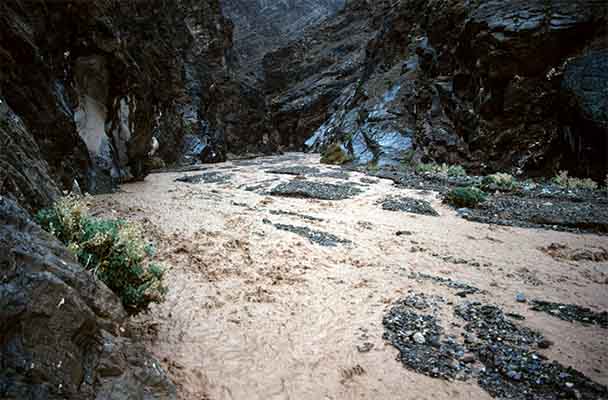Last updated: November 22, 2021
Lesson Plan
Floodwaters in the Desert Lab Activity

- Grade Level:
- Upper Elementary: Third Grade through Fifth Grade
- Subject:
- Science
- Lesson Duration:
- 60 Minutes
- Common Core Standards:
- 4.SL.1.d, 5.SL.1.c, 6.SL.1.c
- Additional Standards:
- Next Generation Science Standards:
4-ESS2-1
5-ESS1-2 - Thinking Skills:
- Understanding: Understand the main idea of material heard, viewed, or read. Interpret or summarize the ideas in own words. Applying: Apply an abstract idea in a concrete situation to solve a problem or relate it to a prior experience. Analyzing: Break down a concept or idea into parts and show the relationships among the parts.
Essential Question
How does precipitation change desert landscapes?
Objective
Students will be able to:
• use the word precipitation to describe rainfall.
• observe the effect of floodwater.
• make a hypothesis, observation, then a conclusion with given data.
• record and make conclusions about how canyons form.
• describe and analyze how rainfall can affect landforms.
Background
Lesson Overview: Students will explore precipitation through discussion, videos, and a PowerPoint presentation. For the lab activity, students will explore the way flood waters can affect the landscape and topography in the desert. Students will observe what happens to the landscape as different amounts of water are dropped on the hillside.
Water shapes the canyons of Death Valley National Park. While Death Valley receives only 2 inches of rain on average, water is a powerful force. Floodwaters from rainstorms carry rocks, gravel, and sand down from surrounding mountains and deposits them on the valley floor.
Partially due to sparse vegetation, desert soils tend to be hard-packed and do not soak up water quickly. Steep slopes in Death Valley also tend to shed rain rather than absorb it. This water channels into low spots such as canyons and can cause flash floods.
Flash floods can cause very expensive damage to roads and infrastructure. They can also be dangerous. Yet these same flash floods are a major force behind the stark beauty of Death Valley—from Golden Canyon to Badwater Basin.
Preparation
Each group of students will need:
- 1 plastic shoebox
- 5 rocks different sizes
- 2 cups of dirt sand mixture
- 1 Spray bottle
- 1 watering can or two small cups of water
- Flood data record sheets for each student
Materials
This short PowerPoint covers the vocabulary needed for the lab activity.
Download Floodwaters in the Desert Vocabulary Presentation
Students use this data record sheet to record their hypotheses and observations during the flood lab activity.
Download Floodwaters Lab Data Record Sheet
Lesson Hook/Preview
Anticipatory Set
Ask students to discuss a time when they saw a lot of rain or snow fall from the sky. Ask them what the land looked like before and after the rainfall. Engage students by asking this question: Do you think rainfall can change the landscape?
Procedure
Vocabulary
Teach students correct vocabulary using the Floods Vocabulary Powerpoint
Making the Landscape
-
Fill shoebox with rocks and dirt making a slope like feature. It’s a good idea to put larger rocks on the bottom before they add dirt to create a bedrock type feel.
- They can use their hands to make sure the dirt is packed well and there is a small dip in the side of the hill for a little bit of a canyon.
Creating the Flood
-
First students should make their hypothesis for each part on the Flood Data Record Sheet.
- Students can use the spray bottle to lightly spray making the hillside a little damp. After each round of “precipitation” or rainfall students should record what actually happened.
- Next, students can use the watering can or cup of water to create a slow rainfall.
- Then, students can use the two cups to create the flood like demonstration.
- Students should answer the questions on the Flood Data Record Sheet as they do each step.
Extension Questions
What happens when you move the tray? Does it look different after it was moved? What does this simulate?
What can happen if you leave it in the sun? Does the water evaporate? What happened to the dirt? What does this simulate?
Extension Activity
After the lesson, show Death Valley National Park’s video, “October 2015 Floods”
Ask the students to list similarities and differences between the video and their model. This could be explored through a graphic organizer, such as a Venn diagram, on the board or on paper.
Vocabulary
Weathering: The process of breaking large rocks into smaller rocks over time.
Erosion: The movement of weathered rock and soil from one place to another.
Flood: An overflowing of a large amount of water beyond its normal levels, especially over what is normally dry land
Precipitation: Rain or hail that falls to the ground
Assessment Materials
Student data sheet can serve as an assessment to see if they understand the concept of how flooding in the desert can change a landscape. It can also serve as an assessment for the science process standards.
Related Lessons or Education Materials
This lesson plan pairs with our geology-focused field trips, such as Dynamic Death Valley and Shifting Sands programs.
This lesson plan was developed through the Teacher-Ranger-Teacher program. Please provide us with feedback on this lesson plan by adding a review or using the contact link below. Thank you!
